When one thinks of the PlayStation 1 (PS1), the immediate association for many is horror. Titles like “Silent Hill” created such a profound impact that they overshadowed the console’s extensive library of genres. The perception that the PS1 was merely a vessel for chilling, viscerally dark content may mislead newer gamers into disregarding the console’s versatility. Indeed, platforms like Itch.io offer a treasure trove of games that echo this sentiment, primarily leaning into the realms of grotesque fear. However, there’s a need to illuminate the vibrant spectrum of experiences the PS1 facilitated, ranging from adventure epics to imaginative escapades, one of which is exemplified by the innovative work of New York City-based game designer Hatim Benhsain.
Benhsain’s “Water Level/b.l.u.e. EXPLORATION” serves as a refreshing reminder of the color and life that can emerge from the melancholy traditionally associated with the PS1. This free downloadable title is a contemporary reimagining of “b.l.u.e.: Legend of Water,” a Japan-exclusive title in which players explore alien ruins alongside a dolphin. Yet, the brilliance of Benhsain’s creation lies in its transformative nature: it’s less about straightforward emulation and more about redefining boundaries between nostalgia and innovation.
In this playful exploration, the world is crafted from fragments of memories, seamlessly intertwining different game landscapes. Players find themselves traversing a uniquely vibrant environment that merges elements from iconic titles like “Dark Souls,” “Super Mario 64,” and “Kingdom Hearts.” This collage of experiences emerges as a testament to the power of adaptation in the gaming medium and challenges conventional definitions of gameplay norms.
Benhsain coins the term “plunderludic,” which hints at the playful theft and rearrangement of game elements to create something entirely new. This layered approach invites players to engage not only with the mechanics but also with the cultural heritage and evolution of video games. Unlike traditional remakes or remasters, plunderludic design challenges the typical nature of replication, transmuting the essence of original games into a vibrant tapestry of homage and reinterpretation.
The term invokes thoughts of avant-garde art movements that sought to deconstruct and reassemble established forms. For instance, connections with Bertolt Brecht’s playwriting methodologies and George Maciunas’ Fluxus movement illustrate the conceptual depth behind this game. Both figures emphasized the rethinking of art forms, making the distillation of this concept in videogames particularly fascinating. As players navigate through the game, they are both spectators and participants, engaging with a myriad of references and experiences that compels them to consider the broader context of the medium.
Amidst the contemporary gaming landscape, it is easy to overlook the magic once found in underwater exploration. While modern titles may boast stunning graphics and simulated aquatic physics, there’s something uniquely charming about the simplicity of early explorative games. “Water Level/b.l.u.e. EXPLORATION,” with its emphasis on swimming as both a gameplay mechanic and artistic endeavor, rekindles that nostalgic joy. It provides a serene escape that contrasts with the often chaotic mechanics seen in more recent titles like “Subnautica.”
Players experience a gratifying sense of buoyancy that evokes childlike wonderment, facilitating an emotional connection that standard gameplay sometimes neglects. The lack of heavy-handed combat and instead implementing exploration fosters a calming atmosphere, encouraging gamers to relish the journey rather than focusing solely on objectives.
As we navigate the evolution of game design, it is crucial to remember that video games have the potential to provide diverse experiences grounded in myriad emotions and aesthetics. “Water Level/b.l.u.e. EXPLORATION” stands as a potent reminder of the PS1’s rich legacy and its impact on contemporary game developers. By analyzing and practicing plunderludic design, we can continue to discover unexplored depths within the gaming universe. It ultimately beckons players to reflect on their favorite water levels—both old and new—and reignite that passion for exploration.
In a world filled with fleeting trends, games that celebrate nostalgic design principles and foster a sense of wonder continually remind us of the magic video games can evoke.


Leave a Reply